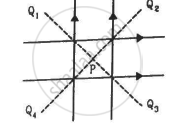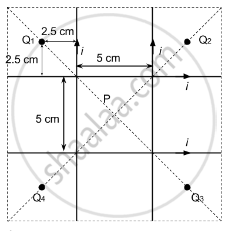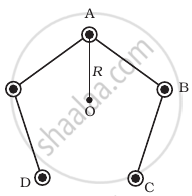Advertisements
Advertisements
Question
Four long, straight wires, each carrying a current of 5.0 A, are placed in a plane as shown in figure. The points of intersection form a square of side 5.0 cm.
(a) Find the magnetic field at the centre P of the square.
(b) Q1, Q2, Q3, and Q4, are points situated on the diagonals of the square and at a distance from P that is equal to the diagonal of the square. Find the magnetic fields at these points.

Solution

Given:
Let the horizontal wires placed at the bottom and top are denoted as W1 and W2 respectively.
Let the vertical wires placed at the right and left to point P are denoted as W3 and W4 respectively.
Magnitude of current, I = 5 A
(a) Consider point P.
Magnetic fields due to wires W1 and W2 are the same in magnitude, but they are opposite in direction.
Magnetic fields due to wires W3 and W4 are the same in magnitude, but they are opposite in direction.
Hence, the net magnetic field is zero.
Net magnetic field at P due to these four wires = 0
(b) Consider point Q1.
Due to wire W1, separation of point Q1 from the wire (d) is 7.5 cm.
So, the magnetic field due to current in the wire is given by
\[B_{W_1} = \frac{\mu_0 I}{2\pi d}\]
= 4 × 10−5 T (In upward direction)
Due to wire W2, separation of point Q1 from the wire (d) is 2.5 cm.
So, the magnetic field due to current in the wire is given by
\[B_{W_2} = \frac{4}{3} \times {10}^{- 5} T\] (In upward direction)
Due to wire W3, separation of point Q1 from the wire (d) is 7.5 cm.
So, the magnetic field due to current in the wire is given by
BW3 = 4 × 10−5 T (In upward direction)
Due to wire W4, separation of point Q1 from the wire (d) is 2.5 cm.
So, the magnetic field due to current in the wire is given by
\[B_{W_4} = \frac{4}{3} \times {10}^{- 5} T\] (In upward direction)
∴ Net magnetic field at point Q1
\[B_{Q_1} = \left( 4 + \frac{4}{3} + 4 + \frac{4}{3} \right) \times {10}^{- 5} \]
\[ = \frac{32}{3} \times {10}^{- 5} \]
\[ = 1 . 06 \times {10}^{- 4} T (\text{ In upward direction })\]
Magnetic field due to wire W1:
BW1 = 4 × 10−5 T (In upward direction)
Magnetic field due to wire W2:
∴ Net magnetic field at point Q2, \[B_{Q_2} = 0\]
APPEARS IN
RELATED QUESTIONS
The figure shows three infinitely long straight parallel current carrying conductors. Find the
(i) magnitude and direction of the net magnetic field at point A lying on conductor 1,
(ii) magnetic force on conductor 2.

Derive the expression for force per unit length between two long straight parallel current carrying conductors. Hence define one ampere.
An electron is moving along the positive x-axis. You want to apply a magnetic field for a short time so that the electron may reverse its direction and move parallel to the negative x-axis. This can be done by applying the magnetic field along
(a) y-axis
(b) z-axis
(c) y-axis only
(d) z-axis only
Two parallel, long wires carry currents i1 and i2 with i1 > i2. When the currents are in the same direction, the magnetic field at a point midway between the wires is 10 µT. If the direction of i2 is reversed, the field becomes 30 µT. The ratio i1/i2 is
A long, straight wire of radius R carries a current distributed uniformly over its cross section. T he magnitude of the magnetic field is
(a) maximum at the axis of the wire
(b) minimum at the axis of the wire
(c) maximum at the surface of the wire
(d) minimum at the surface of the wire.
A current of 10 A is established in a long wire along the positive z-axis. Find the magnetic field \[\vec{B}\] at the point (1 m, 0, 0).
A transmission wire carries a current of 100 A. What would be the magnetic field B at a point on the road if the wire is 8 m above the road?
A long, straight wire of radius r carries a current i and is placed horizontally in a uniform magnetic field B pointing vertically upward. The current is uniformly distributed over its cross section. (a) At what points will the resultant magnetic field have maximum magnitude? What will be the maximum magnitude? (b) What will be the minimum magnitude of the resultant magnetic field?
A hypothetical magnetic field existing in a region is given by `vecB = B_0 vece` where `vece`_r denotes the unit vector along the radial direction. A circular loop of radius a, carrying a current i, is placed with its plane parallel to the x−y plane and the centre at (0, 0, d). Find the magnitude of the magnetic force acting on the loop.
A straight wire of length l can slide on two parallel plastic rails kept in a horizontal plane with a separation d. The coefficient of friction between the wire and the rails is µ. If the wire carries a current i, what minimum magnetic field should exist in the space in order to slide the wire on the rails?
A rectangular coil of 100 turns has length 5 cm and width 4 cm. It is placed with its plane parallel to a uniform magnetic field and a current of 2 A is sent through the coil. Find the magnitude of the magnetic field B if the torque acting on the coil is 0.2 N m−1
A long, straight wire carries a current i. Let B1 be the magnetic field at a point P at a distance d from the wire. Consider a section of length l of this wire such that the point P lies on a perpendicular bisector of the section B2 be the magnetic field at this point due to this second only. Find the value of d/l so that B2 differs from B1 by 1%.
Define Ampere in terms of force between two current carrying conductors.
Answer the following question.
Two infinitely long straight wire A1 and A2 carrying currents I and 2I flowing in the same direction are kept' distance apart. Where should a third straight wire A3 carrying current 1.5 I be placed between A1 and A2 so that it experiences no net force due to A1 and A2? Does the net force acting on A3 depend on the current flowing through it?
Equal currents are passing through two very long and straight parallel wires in the same direction. They will ______
Five long wires A, B, C, D and E, each carrying current I are arranged to form edges of a pentagonal prism as shown in figure. Each carries current out of the plane of paper.

- What will be magnetic induction at a point on the axis O? AxisE is at a distance R from each wire.
- What will be the field if current in one of the wires (say A) is switched off?
- What if current in one of the wire (say) A is reversed?
Two long straight parallel conductors carrying currents I1 and I2 are separated by a distance d. If the currents are flowing in the same direction, show how the magnetic field produced by one exerts an attractive force on the other. Obtain the expression for this force and hence define 1 ampere.
